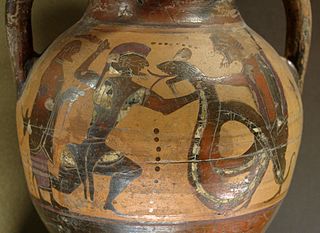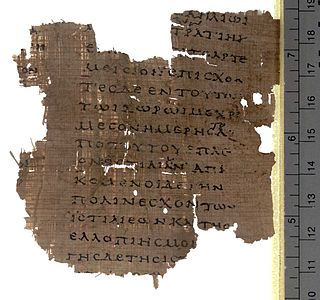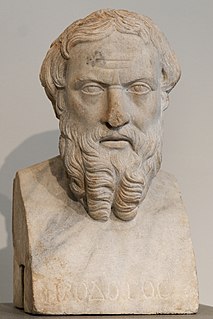
Hades, in the ancient Greek religion and myth, is the god of the dead and the king of the underworld, with which his name became synonymous. Hades was the eldest son of Cronus and Rhea, although the last son regurgitated by his father. He and his brothers, Zeus and Poseidon, defeated their father's generation of gods, the Titans, and claimed rulership over the cosmos. Hades received the underworld, Zeus the sky, and Poseidon the sea, with the solid earth, long the province of Gaia, available to all three concurrently. Hades was often portrayed with his three-headed guard dog Cerberus.

Resurrection is the concept of coming back to life after death. In a number of ancient religions, a dying-and-rising god is a deity which dies and resurrects.

Semele, in Greek mythology, was the youngest daughter of the Boeotian hero Cadmus and Harmonia, and the mother of Dionysus by Zeus in one of his many origin myths.
In ancient Greek religion and mythology, Zagreus was sometimes identified with a god worshipped by the followers of Orphism, the “first Dionysus”, a son of Zeus and Persephone, who was dismembered by the Titans and reborn. However, in the earliest mention of Zagreus, he is paired with Gaia (Earth) and called the “highest” god [of the underworld?] and Aeschylus links Zagreus with Hades, possibly as Hades' son, or Hades himself. Noting "Hades' identity as Zeus' katachthonios alter ego", Timothy Gantz thought it "likely" that Zagreus, originally, perhaps the son of Hades and Persephone, later merged with the Orphic Dionysus, the son of Zeus and Persephone.
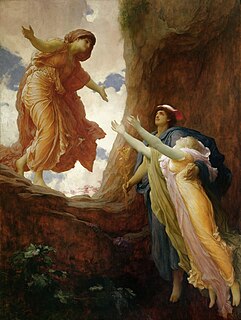
A dying-and-rising, death-rebirth, or resurrection deity is a religious motif in which a god or goddess dies and is resurrected. "Death or departure of the gods" is motif A192 in Stith Thompson's Motif-Index of Folk-Literature (1932), while "resurrection of gods" is motif A193.
Dionysus-Osiris, or alternatively, Osiris-Dionysus, is a deity that arises from the syncretism of the Egyptian god Osiris and the Greek god Dionysus. As early as the 5th century BC, the two deities had been identified with each other, seen most notably in the historian Herodotus' 'Histories'. Other syncretic GrecoEgyptian deities arose out of these conflations, such as Serapis and Hermanubis. Dionysus-Osiris was particularly popular in Ptolemaic Egypt, as the Ptolemies claimed descent from Dionysus, and as Pharaoes they had claim to the lineage of Osiris. This association was most notable during a deification ceremony where Mark Antony became Dionysus-Osiris, alongside Cleopatra as Isis-Aphrodite.

Ancient Greek religion encompasses the collection of beliefs, rituals, and mythology originating in ancient Greece in the form of both popular public religion and cult practices. These groups varied enough for it to be possible to speak of Greek religions or "cults" in the plural, though most of them shared similarities.

In ancient Greek religion and mythology, the twelve Olympians are the major deities of the Greek pantheon, commonly considered to be Zeus, Hera, Poseidon, Demeter, Athena, Apollo, Artemis, Ares, Aphrodite, Hephaestus, Hermes, and either Hestia or Dionysus. They were called Olympians because, according to tradition, they resided on Mount Olympus.

Sais or Sa El Hagar was an ancient Egyptian town in the Western Nile Delta on the Canopic branch of the Nile. It was the provincial capital of Sap-Meh, the fifth nome of Lower Egypt and became the seat of power during the Twenty-fourth Dynasty of Egypt and the Saite Twenty-sixth Dynasty of Egypt during the Late Period. Its Ancient Egyptian name was Zau.

Interpretatio graeca is a discourse in which ancient Greek religious concepts and practices, deities, and myths are used to interpret or attempt to understand the mythology and religion of other cultures. It is thus a comparative methodology that looks for equivalencies and shared characteristics. The phrase may describe Greek efforts to explain others' beliefs and myths, as when Herodotus describes Egyptian religion in terms of perceived Greek analogues, or when Dionysius of Halicarnassus and Plutarch document Roman cults, temples, and practices under the names of equivalent Greek deities. Interpretatio graeca may also describe non-Greeks' interpretation of their own belief systems by comparison or assimilation with Greek models, as when Romans adapt Greek myths and iconography under the names of their own gods.

The study of Jesus in comparative mythology is the examination of the narratives of the life of Jesus in the Christian gospels, traditions and theology, as they relate to Christianity and other religions. Although virtually all New Testament scholars and historians of the ancient Near East agree that Jesus existed as a historical figure, most secular historians also agree that the gospels contain large quantities of ahistorical legendary details mixed in with historical information about Jesus's life. The Synoptic Gospels of Mark, Matthew, and Luke are heavily shaped by Jewish tradition, with the Gospel of Matthew deliberately portraying Jesus as a "new Moses". Although it is highly unlikely that the authors of the Synoptic Gospels directly based any of their stories on pagan mythology, it is possible that they may have subtly shaped their accounts of Jesus's healing miracles to resemble familiar Greek stories about miracles associated with Asclepius, the god of healing and medicine. The birth narratives of Matthew and Luke are usually seen by secular historians as legends designed to fulfill Jewish expectations about the Messiah.

The Dionysian Mysteries were a ritual of ancient Greece and Rome which sometimes used intoxicants and other trance-inducing techniques to remove inhibitions and social constraints, liberating the individual to return to a natural state. It also provided some liberation for those marginalized by Greek society: women, slaves, outlaws, and non-citizens. In their final phase the Mysteries shifted their emphasis from a chthonic, underworld orientation to a transcendental, mystical one, with Dionysus changing his nature accordingly. By its nature as a mystery religion reserved for the initiated, many aspects of the Dionysian cult remain unknown and were lost with the decline of Greco-Roman polytheism; modern knowledge is derived from descriptions, imagery and cross-cultural studies.

The Jesus Mysteries: Was the "Original Jesus" a Pagan God? is a 1999 book by British authors Timothy Freke and Peter Gandy, which advances the argument that early Christianity originated as a Greco-Roman mystery cult and that Jesus was invented by early Christians based on an alleged pagan cult of a dying and rising "godman" known as Osiris-Dionysus, whose worship the authors claim was manifested in the cults of Osiris, Dionysus, Attis, and Mithras. This thesis is a fringe theory and is not accepted by mainstream scholars.

Serapis or Sarapis is a Graeco-Egyptian deity. The cult of Serapis was introduced during the third century BC on the orders of Pharaoh Ptolemy I Soter of the Ptolemaic Kingdom as a means to unify the Greeks and Egyptians in his realm. A serapeum was any temple or religious precinct devoted to Serapis. The cultus of Serapis was spread as a matter of deliberate policy by the Ptolemaic kings, who also built the immense Serapeum of Alexandria. Serapis continued to increase in popularity during the Roman Empire, often replacing Osiris as the consort of Isis in temples outside Egypt.
The traditional Berber religion is the ancient and native set of beliefs and deities adhered to by the Berber autochthones of North Africa. Many ancient Berber beliefs were developed locally, whereas others were influenced over time through contact with other traditional African religions, or borrowed during antiquity from the Punic religion, Judaism, Iberian mythology, and the Hellenistic religion. The most recent influence came from Islam and pre-Islamic Arab religion during the medieval period. Some of the ancient Berber beliefs still exist today subtly within the Berber popular culture and tradition. Syncretic influences from the traditional Berber religion can also be found in certain other faiths.
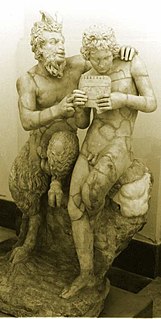
Deities depicted with horns or antlers are found in many different religions across the world.

A funerary cult is a body of religious teaching and practice centered on the veneration of the dead, in which the living are thought to be able to confer benefits on the dead in the afterlife or to appease their otherwise wrathful ghosts. Rituals were carried on for the benefit of the dead, either by their relatives or by a class of priests appointed and paid to perform the rites. These rituals took place at the tombs of the dead themselves or at mortuary temples appointed to this purpose. Funerary cults are found in a wide variety of cultures.

A vegetation deity is a nature deity whose disappearance and reappearance, or life, death and rebirth, embodies the growth cycle of plants. In nature worship, the deity can be a god or goddess with the ability to regenerate itself. A vegetation deity is often a fertility deity. The deity typically undergoes dismemberment, scattering, and reintegration, as narrated in a myth or reenacted by a religious ritual. The cyclical pattern is given theological significance on themes such as immortality, resurrection, and reincarnation. Vegetation myths have structural resemblances to certain creation myths in which parts of a primordial being's body generate aspects of the cosmos, such as the Norse myth of Ymir.
